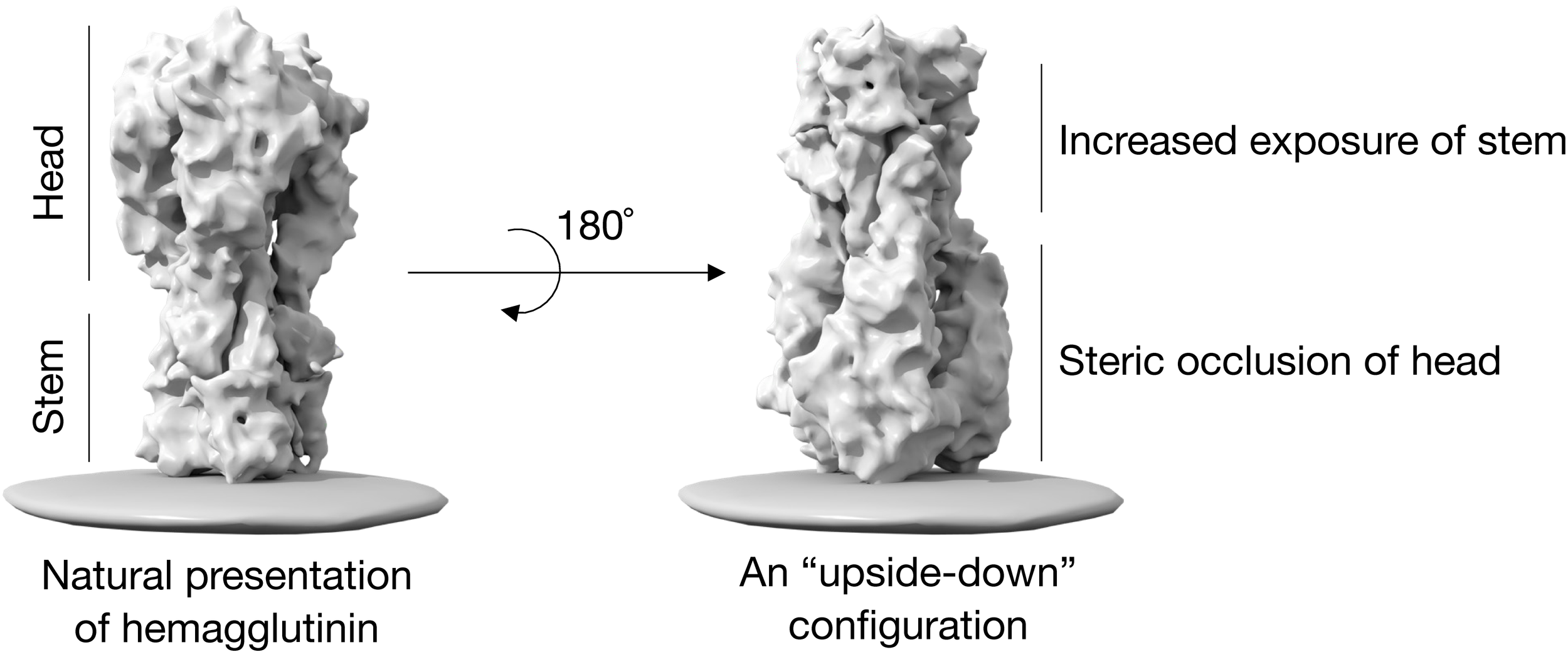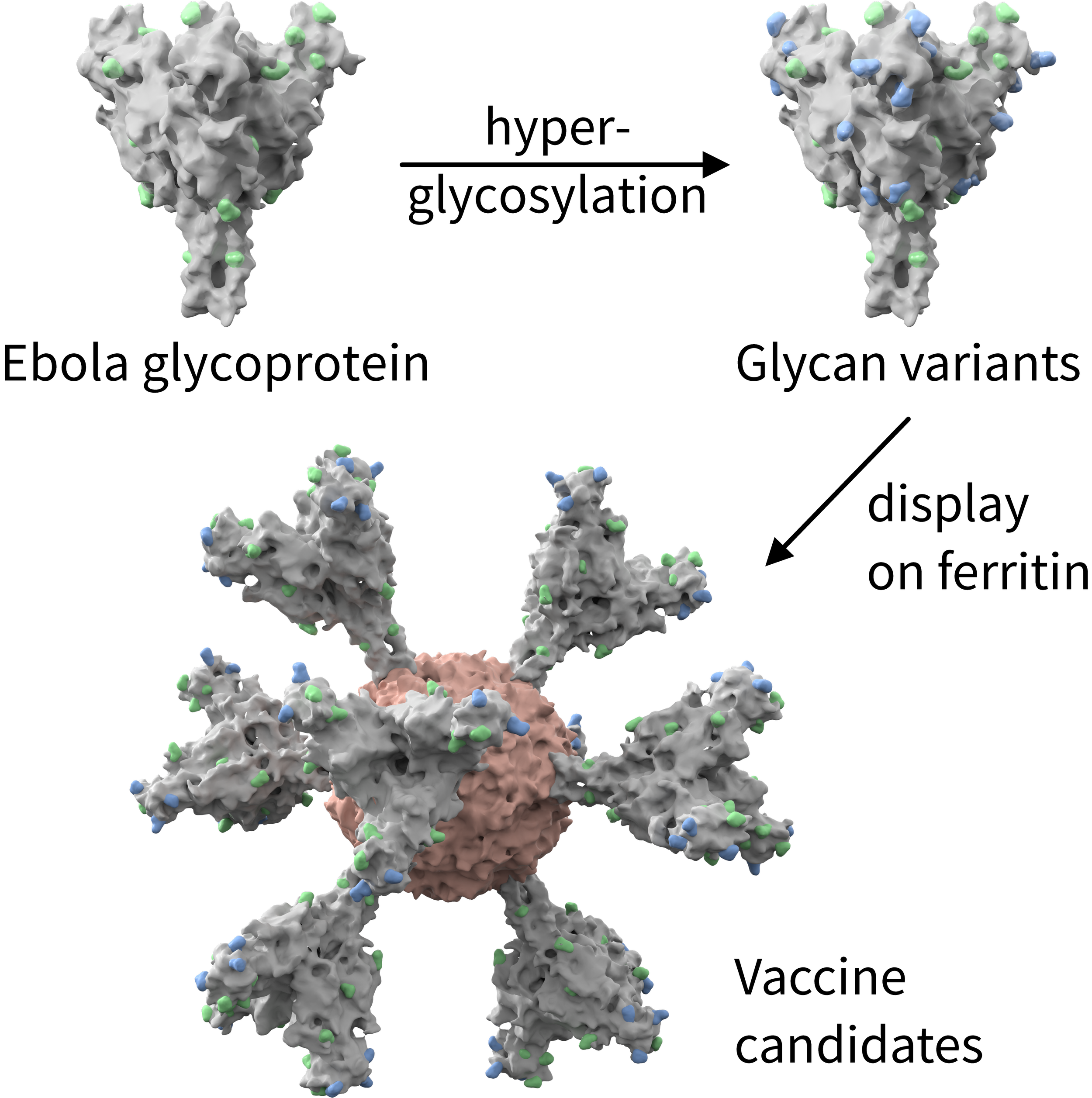research topics
Vaccines and Immunofocusing
Smallpox has been eradicated. Three infectious agents (polio, measles, rubella) have been targeted for elimination by the World Health Organization and another seven have been at least 90% eradicated in the U.S. largely due to the efficacy of vaccines. But it has not been possible to create vaccines for some of the most important infectious diseases. We aim to create vaccines for such difficult targets and to devise new strategies to enable vaccine generation. Our vaccine targets include HIV-1, pandemic influenza, Ebola, and SARS-CoV-2.
Our research is primarily focused on eliciting antibody-mediated immune responses. There are known monoclonal antibodies (mAbs) that can provide broad protection against HIV-1, pandemic influenza, and Ebola – but generating vaccines that elicit antibodies with properties of these mAbs has not been possible. Accordingly, a major goal of our research is to devise new protein engineering strategies to enable immunofocusing – the creation of vaccines capable of eliciting an antibody response against a targeted epitope.
Various “immunofocusing” strategies have been employed in attempts to elicit a polyclonal antibody response toward a specific epitope. Nonetheless, to date, it has not been possible to create a vaccine that elicits a bnAb-like response. A major challenge in vaccine development, therefore, especially against rapidly evolving viruses, is the ability to focus the immune response toward evolutionarily conserved antigenic regions that have been shown, with mAbs, to confer broad protection.
A major goal of our research is to develop and implement immunofocusing methods to enable generation of vaccines that address major unmet medical needs. These methods include a new immunofocusing strategy, antigen reorientation, accomplished by site-specific insertion of aspartate residues (oligoD) into antigens to facilitate their binding to alum adjuvants. We applied this approach to an H2 HA to create an “upside-down” configuration on alum, which sterically occluded HA-head while exposing HA-stem to the immune system (Fig. 1). Immunization with this reoriented H2 HA (reoH2HA) induced a stem-directed, cross-reactive response in mice to diverse HAs from both group 1 and group 2 influenza A subtypes. The simplicity of oligoD-based antigen reorientation will enable and accelerate the development of epitope-focused vaccines against many other viruses and infectious agents.
Figure 1. Design of a universal flu vaccine by antigen reorientation. Influenza hemagglutinin (HA) is reoriented in an “upside-down” configuration to sterically occlude its head and redirect the antibody response to the more exposed stem.
We also utilize structure-guided design of vaccine candidates with hyperglycosylation that aims to direct antibody responses away from variable regions and toward conservative epitopes of an antigen. In this manner, we have introduced a universal Ebola virus vaccine approach aimed at conferring cross-protective immunity against the three species that have resulted in human Ebola outbreaks: Zaire, Bundibugyo, and Sudan viruses (Fig. 2).
Figure 2. Design of a universal Ebola vaccine candidate. Eight copies of hyperglycosylated Ebola glycoproteins (GPs) are displayed on each ferritin nanoparticle. Hyperglycosylation is used to direct antibody responses away from variable regions and toward conserved epitopes on GP.
We introduced a method for creating epitope-focused vaccines called PMD (for protect, modify, deprotect). The steps for PMD are: (i) protect an epitope on a protein by binding a bnAb, (ii) modify the bnAb–antigen complex chemically to render solvent-exposed surfaces non-immunogenic, and (iii) deprotect the epitope by dissociating the bnAb–antigen complex. This produces an antigen in which the only unmodified region is the epitope of the bnAb (Fig. 3). In our proof-of-concept study, using influenza hemagglutinin (HA), we demonstrated that PMD is capable of low-resolution epitope focusing.
Figure 3. Schematic of the PMD strategy. First, the epitope is protected by combining the mAb (blue hashed) with the antigen (orange). Then the surfaces of the complex are modified to render them non-immunogenic (shown as darker shading). Finally the epitope is deprotected by removal of the mAb.
While the rapid development of COVID-19 vaccines has been a scientific triumph, the need remains for a globally available vaccine that provides longer-lasting immunity against present and future SARS-CoV-2 variants of concern (VOCs). We generated DCFHP (Delta-C70-Ferritin-HexaPro), a SARS-CoV-2 spike-functionalized, ferritin-based, protein-nanoparticle that, when formulated with aluminum hydroxide as the sole adjuvant (DCFHP-alum), elicits potent and durable neutralizing antisera in non-human primates (NHPs) against known VOCs, including Omicron BQ.1, as well as against SARS-CoV-1. Following a booster approximately one year after the initial immunization, DCFHP-alum elicits a robust anamnestic response. To enable global accessibility, we generated a cell line that can enable production of thousands of vaccine doses per liter of cell culture and showed that DCFHP-alum maintains potency for at least 14 days at temperatures exceeding standard room temperature. DCFHP-alum has potential as a highly durable booster vaccine, and as a primary vaccine for pediatric use including in infants.
We aim to understand a key outstanding basic science question: how does DCFHP-alum elicit durable, broad-spectrum neutralizing activity? Our approaches include characterization of the epitopes and the immunodominance of neutralizing antibodies in serum samples from NHPs and mice immunized with DCFHP-alum. We are also interrogating the B cell repertoires, for both plasma and memory B cells, at various times following immunization. We seek to identify key mAbs that allow for a detailed understanding of broad neutralization activity against VOCs.
Figure 4. A structural representation depicting a 24-subunit nanoparticle SARS-CoV-2 vaccine. The figure is based on the H. pylori ferritin crystal structure (rust, PDB 3BVE) and the spike trimer cryo-EM structure (blue, PDB 6VXX). The receptor-binding domain (RBD) of the spike protein is highlighted in dark blue.
publication highlights
Engineering a SARS-CoV-2 vaccine targeting the RBD cryptic-face via immunofocusing.
Theodora U.J. Bruun, Jonathan Do, Payton A.-B. Weidenbacher, Peter S. Kim. https://doi.org/10.1101/2024.06.05.597541 bioRxiv (2024).
Bringing immunofocusing into focus. (PDF) (npj Vaccines)
Sriharshita Musunuri, Payton A. B. Weidenbacher, Peter S. Kim. Npj Vaccines (2024). doi.org/10.1038/s41541-023-00792-x.
Vaccine design via antigen reorientation. (PDF) (Nat. Chem. Bio)
Duo Xu, Joshua J. Carter, Chunfeng Li, Ashley Utz, Payton A. B. Weidenbacher, Shaogeng Tang, Mrinmoy Sanyal, Bali Pulendran, Christopher O. Barnes, Peter S. Kim. Nature Chemical Biology (2024). doi.org/10.1038/s41589-023-01529-6.
Design of universal Ebola virus vaccine candidates via immunofocusing. (PDF) (PNAS)
Duo Xu, Abigail E. Powell, Ashley Utz, Mrinmoy Sanyal, Jonathan Do, J. J. Patten, Juan I. Moliva, Nancy J. Sullivan, Robert A. Davey, Peter S. Kim. Proc. Natl. Acad. Sci. USA (2024). doi.org/10.1073/pnas.2316960121.
A ferritin-based COVID-19 nanoparticle vaccine that elicits robust, durable, broad-spectrum neutralizing antisera in non-human primates.
(PDF) (Nat. Com.)
Payton A.-B. Weidenbacher, Mrinmoy Sanyal, Natalia Friedland, Shaogeng Tang, Prabhu S. Arunachalam, Mengyun Hu, Ozan S. Kumru, Mary Kate Morris, Jane Fontenot, Lisa Shirreff, Jonathan Do, Ya-Chen Cheng, Gayathri Vasudevan, Mark B. Feinberg, Francois J. Villinger, Carl Hanson, Sangeeta B. Joshi, David B. Volkin, Bali Pulendran, Peter S. Kim. Nature Communications (2023). 2022 Dec 26:2022.12.25.521784. doi: 10.1101/2022.12.25.521784.
Formulation development and comparability studies with an aluminum-salt adjuvanted SARS-CoV-2 Spike ferritin nanoparticle vaccine antigen produced from two different cell lines. (PDF) (Vaccine)
Ozan Kumru, Mrinmoy Sanyal, Natalia Friedland, John Hickey, Richa Joshi, Payton Weidenbacher, Jonathan Do, Ya-Chen Cheng, Peter S. Kim, Sangeeta B Joshi, David B Volkin. Vaccine (2023). 2023 Oct 20;41(44):6502-6513. doi.org/10.1016/j.vaccine.2023.08.037.
Decreased efficacy of a COVID-19 vaccine due to mutations present in early SARS-CoV-2 variants of concern.
Payton A Weidenbacher, Natalia Friedland, Mrinmoy Sanyal, Mary Kate Morris, Jonathan Do, Carl Hanson, Peter S. Kim.
https://www.biorxiv.org/content/10.1101/2023.06.27.546764v2 bioRxiv (2023).
A single immunization with spike-functionalized ferritin vaccines elicits neutralizing antibody responses against SARS-CoV-2 in mice.
(PDF) (ACS Cent. Sci.)
Abigail E. Powell, Kaiming Zhang, Mrinmoy Sanyal, Shaogeng Tang, Payton A. Weidenbacher, Shanshan Li, Tho D. Pham, John E. Pak, Wah Chiu, Peter S. Kim. ACS Cent. Sci. (2021). 2021 Jan 27;7(1):183-199. doi: 10.1021/acscentsci.0c01405.
Protect, Modify, Deprotect (PMD): A strategy for creating vaccines to elicit antibodies targeting a specific epitope. (PDF) (PNAS)
Payton A. Weidenbacher and Peter S. Kim. Proc. Natl. Acad. Sci. USA (2019) 116: 9947-9952.



